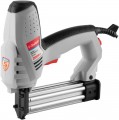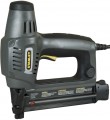Product type
General purpose of the instrument.
A construction stapler in the original sense of the word is called a staple gun — a tool designed to work exclusively with staples. For driving nails, in turn,
nailers are used, while in such devices the matter may not be limited to nails alone. However, the most versatile are the combined models —
2-in-1 and
3-in-1 staplers. Here is a more detailed description of all these varieties:
— Stapler. Stapling tools that are not intended for use with other types of fasteners. One of the most popular areas of application for such devices is furniture production and other activities where it is necessary to sheathe various structures with fabric, mesh, etc.; although, of course, the matter is not limited to this. Anyway, staplers are not as versatile as 2-in-1 and 3-in-1 models, but at the same cost, a highly specialized tool usually turns out to be more performant, practical and reliable than a combination device.
— Nayler. He's also a "nail gun". Tools similar to staplers, but designed to work with nails (sometimes also with pins / studs) and do not involve the use of staples. For a number of reasons, pneumatic nailers are most widely used nowadays, but there are other variations.
— Stapler (2-in-1). Devices that can work with both staples and nails; in other words, a combination of a traditional stapler and
...a nailer in one tool. The main advantage of such models is versatility: a combined tool can replace two specialized ones at once. At the same time, it will cost significantly less than two separate devices, and it will take up less space; and to switch between different types of fasteners in many models, you don’t even need to change the store — just load the desired type of consumables into it. However, if you plan to work with only one type of fastener, you should not buy a combined device so as not to overpay for unnecessary functionality.
— Stapler (3 in 1). Tools from this category are capable of working with staples and nails, as well as with pins (studs). Thus, such models are generally similar to 2 in 1 devices, but they have even more extensive functionality and, accordingly, are somewhat more expensive.Fastener type
—
Nail. Traditional nails are pointed rods with hats. However, hammers are often made for specific types of nails, and ordinary ones cannot be charged in them, this point in each case must be clarified separately. The nail is usually hammered in as a whole, right up to the head; such fasteners are tightly held in the material.
—
Staple. Colloquially, staples are sometimes referred to as "paper clips", although this is not entirely true. Such fasteners are familiar to many from ordinary stationery staplers, however, staples can also be used for more serious tasks — for example, attaching upholstery to wooden furniture. They do not hold as tightly as nails, but the oblong shape of the staple is in some cases a decisive advantage, and reliability is often enough.
—
Pin / hairpin. Fasteners that are driven in the same way as nails, but do not have expanded hats at the top. In addition, they differ somewhat in application: the pin can protrude above the surface of the material, or vice versa, be completely hidden inside, in such a way that then “mask” the fasteners with putty, decorative film, etc. All this requires specific design features, so not every stapler capable of using nails will be compatible with pins / studs.
Fastener sizes
Standard sizes of fasteners for which the tool is designed. This information is necessary for the correct selection of consumables: each standard dimensions corresponds to certain dimensions of parts, and sometimes also design features. There are a great many standards describing standard sizes; they differ not only in the type of fastener, but also in the geography of application and even by specific manufacturers. Detailed data on various standard sizes can be found in special sources; here we will provide general points on some of the most popular options.
First of all, it is worth saying that the standard dimensions describes only two parameters - thickness and width (for nails - size and width of the head). The length can be different: for example, for the popular staple dimensions 53, the length range can be from 4 to 14 mm, and for 140 - from 6 to 14 mm. At the same time, tools for a certain standard dimensions are not necessarily compatible with all length options. So when assessing compatibility with consumables, you should pay attention not only to this point, but also to the restrictions on the minimum and maximum length of fasteners.
This is what the list of the most popular sizes for rectangular brackets looks like:
- 55. One of the smallest sizes used in modern staplers is 6 mm wide and 1.1 mm thick.
- 90. Another relatively small standard dimensions, it has even a slightly smaller width - 5.8 mm - and a thickness in the...range of 1 - 1.27 mm.
— 57. Staples 10.6 mm wide and 1.2 mm thick.
- 59. The “thin” analogue of dimensions 57, with the same width, provides a thickness of only 0.75 mm.
— 140. Quite rigid staples with a width of 10.6 mm and a thickness of 1.24 mm.
- 114. A slightly enhanced variation of dimensions 57, with increased width and thickness - 10.8 mm and 1.4 - 1.6 mm, respectively.
- 53/53F. Quite wide (11.3 mm) staples, available in both 0.75 mm (53) and 1.25 mm (53F) thicknesses.
— 72. In fact, it’s an analogue of the 53 described above: staples 11.3 mm wide and 0.7 mm thick.
- 54/58. Wide staples 12.8 - 12.9 mm, also available in two thicknesses - 0.75 mm in version 58, 1.25 mm in version 54.
Of the semicircular staples used mainly for fastening cables, the most popular options are:
- S. Relatively small staples with a width of 6.2 mm and a thickness of 1.25.
- L. Larger dimensions - 7.7 mm wide with the same 1.25 mm thickness.
In nails for driving tools, the thickness is indicated by the size, and the width by the largest dimensions of the head. The most popular sizes these days are:
— J. Small fastening nails only 1.2 mm thick with a head width of 2 mm.
— N. Diameter 1.65 mm, cap width 2.8 mm.
- DA. The so-called finishing (finishing) nails are quite large in dimensions: size 1.8 mm, head width 3.5 mm. The head has a characteristic D-shape and, as befits finishing nails, when hammered, it is almost completely recessed into the material.
Regarding pins/studs, it is worth noting that such fasteners are actually nails without heads. Therefore, the main dimensions of such parts is thickness (size), for the most common standard sizes it is as follows:
— 40. Thin pins/studs, only 0.64 mm thick.
— 41. Larger fastener, with a size of 1.2 mm.
Detailed information on choosing a standard dimensions for specific tasks can be found in special sources.
Compatible staples
Staple models that the tool is compatible with.
Usually, quite specific options are indicated in this paragraph, so finding compatible consumables is not difficult. The specific dimensions of the fasteners should be specified according to the manufacturer's data — different brands use different markings.
Power consumption
The total power consumed by a mains-powered electric tool (see "Power Source"). It is considered the main criterion for assessing the overall capabilities of a particular model: more power leads to better performance. In addition, data on power consumption also allows you to estimate the load on the power grid or other power source; in some cases this is unnecessary.
Performance
The maximum output of a nailer/stapler is the maximum number of strokes it can produce in a minute. Note that in this case, the theoretical maximum is usually indicated — the highest speed of operation achievable under perfect conditions, in fact — the rate of operation of automation, which in many models exceeds 120 beats / min. In fact, this speed is difficult to achieve, because. the performance of the stapler is noticeably limited by the skills of the operator and the features of the functionality: for example, a tool with contact actuation (see below) must be pressed every time, which reduces the speed of work. However,
high performance clearly indicates good reliability and suitability for large volumes of work.
Magazine capacity
The number of fasteners that fit in the stapler magazine.
Note that manufacturers tend to indicate the maximum number of parts in the characteristics — that is, the capacity for the thinnest fasteners allowed by the design of the tool. Accordingly, fewer larger parts will fit in the store; this must be taken into account when choosing. Nevertheless, this parameter makes it possible to evaluate the instrument and compare models similar in class to each other.
Large capacity, on the one hand, allows you to work longer without interruptions to recharge the stapler. On the other hand, volume magazines are usually very bulky and can weigh a lot on their own, not to mention the weight of the fasteners loaded in them. Also, if parts are charged one at a time, recharging can become quite a long and tedious affair. Therefore, it makes sense to specifically look for a tool
for 100 parts or more(especially when it comes to thick fasteners) only if the ability to work for a long time without reloading is more important than the disadvantages described above.
Max. staple width
The largest width of staples (see Fastener Type) that the stapler can work with.
The width of the bracket is, roughly speaking, the distance between its legs. Different situations and types of work require different sizes of staples, and sometimes the width must be quite large. However, a staple that is too large simply will not fit into the store, not to mention the fact that the stapler can “shoot” it normally. Therefore, this limit cannot be exceeded, and if you plan to work with brackets, you should pay special attention to the maximum width when choosing.
Min. staple length
The smallest length of staples (see Fastener Type) that the stapler can work with.
The length in this case means the length of the leg — in other words, the depth to which the staple clogged "to the stop" penetrates into the material. Small staples do not require much power to drive, but the tool may not be designed for fasteners that are too short due to other parameters — for example, the design of the magazine. Therefore, for many models, this limitation is quite relevant, and in powerful professional models, the minimum length can be quite large — more than 20 mm.

